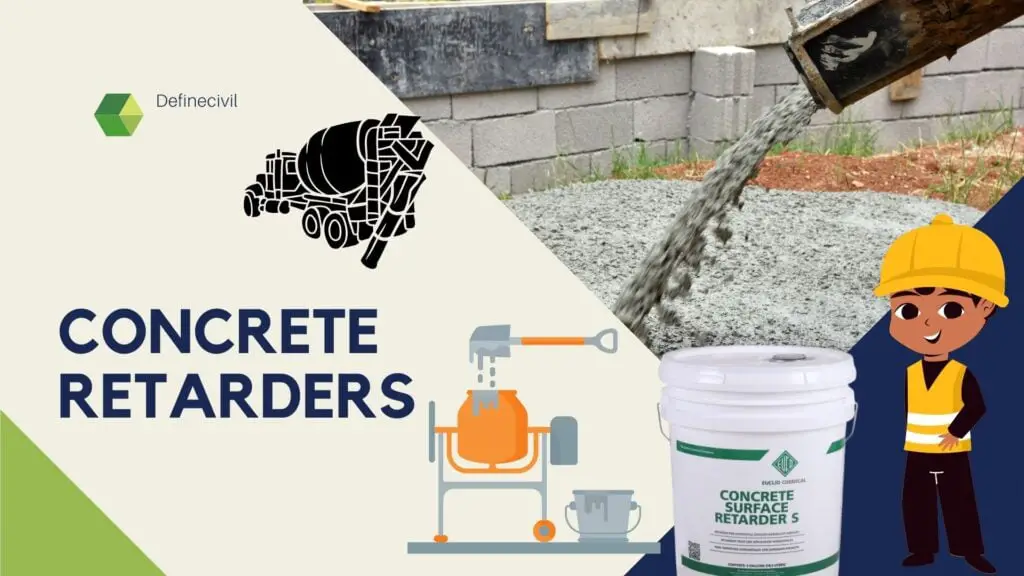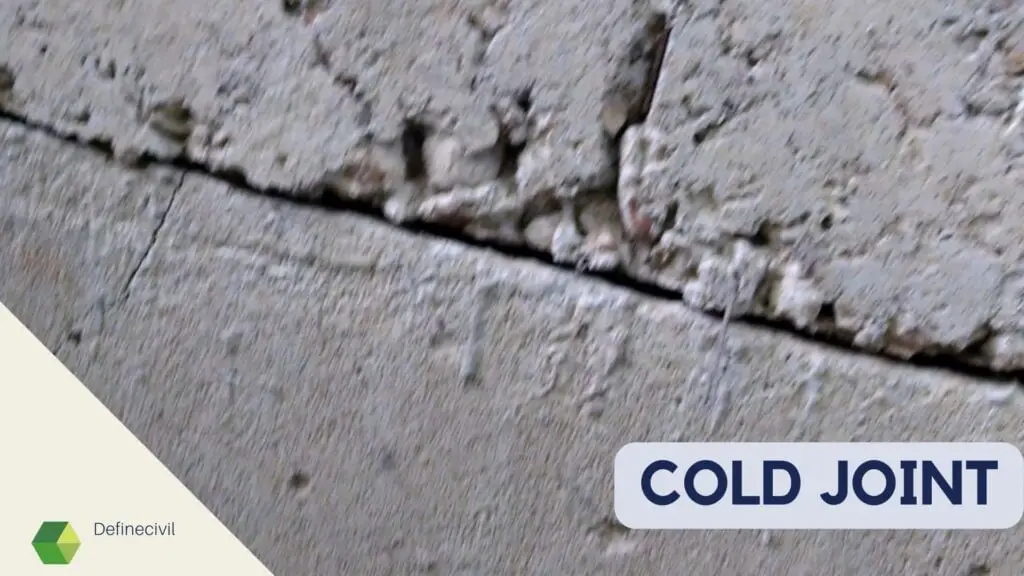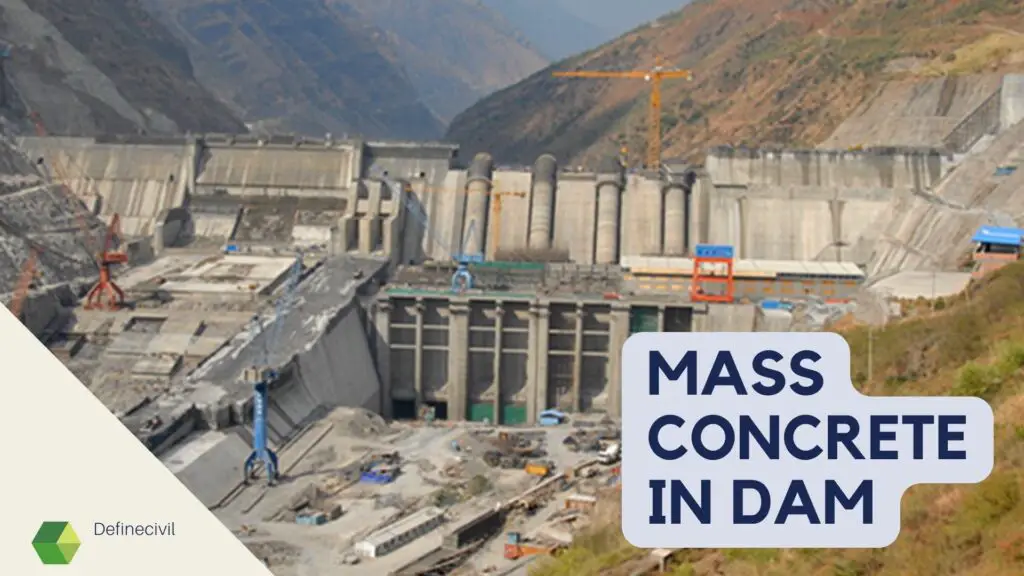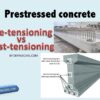Have you ever wondered how civil engineers use concrete retarders to compensate the accelerating effect of high temperature in mass concrete? Or why thy add sugar in concrete while pouring?
The use of concrete retarders as admixture slows down the setting rate of concrete. Slow initial setting time allows site engineers to place concrete in complex structures or prevent cold joints that’s critical in water-retention structures.
Sugar is one of the most common setting retarders or chemical readily available that delays the setting time of concrete. In fact, adding too much sugar can cause indefinite delay in the setting time.
There’re different types of retarding admixtures from organic to inorganic. But the mechanism and its impact on various properties of concrete are quite fascinating to know.
So, in our today’s read we’re going to elaborate some unique aspects of concrete retarders, why is it used for, how is it made, or how to use one in your project.
So, let’s delve in:
Admixtures
Let’s first review some important aspects of general admixtures in concrete:
Concrete admixtures are made from natural or man-made chemicals to give special properties to concrete. These admixtures are added to concrete during mixing to give specific properties such as workability, strength, increasing setting time or developing of early strength.
Various types of admixtures are
- Water Reducing Admixtures
- Retarding Admixtures
- Accelerating Admixtures
- Air entraining concrete admixture
- Pozzolanic Admixtures
- Damp-proofing Admixtures
- Gas forming Admixtures
- Air detraining Admixture

Retarding Admixture
Retarders are one of its type of admixtures used for increasing the initial setting time of concrete. Anyhow, in hot weather conditions concrete take very less time to set due to high temperature. Retarders are added in concrete during hot weather conditions which provide enough time for mixing, transportation, placing and compaction of concrete.
Without the use of retarders, it will be difficult for labor to place concrete as high temperature will increase the setting rate and hardening of concrete mix. Most common retarders include Gypsum (Calcium Sulfate), common sugar, Lignosulfonic acids.
Also Read: Superplasticizer – Types – Function – Advantages & Disadvantages
Mechanism of retardation
Retarder is mixed in concrete by different methods. It can be done by adding a retarder in concrete mixing water or by spraying a retarder solution on concrete which helps in slow down the hydration process which give enough time for initial setting of concrete.
Different ways by which retardation process happen are explained below.
Adsorption
Adsorption is a process in which a protective layer of retarding admixture is formed around cement particles which prevent water to react with cement. As we know hydration of cement cause initial setting. By preventing water to react with cement slow the hydration process and initial setting time of cement increases.
Also Read: Curing of Concrete – Methods – Temperature -Stages
Nucleation
It is a process in which Calcium and hydroxyl ions are formed when water react with cement during mixing. A retarding admixture which are added are adsorbed by these ions and prevent the growth of calcium hydroxide nuclei which results in increasing initial setting time.

Precipitation
This process is almost same as adsorption the only difference is that in precipitation the retarders react with calcium and hydroxyl ions and form insoluble derivatives which form a protective coating around cement particles and prevent water to contact with cement for hydration and in this why setting time of concrete increases.
Types of retarders
There are two types of retarders
Organic retarders
- Phosphonates
- Sugars
- Lignosulphonates
Inorganic retarders
- Phosphonates
- Borates
- Salts of Pb, Zn, Cu, As, Sb
Effects of admixtures on concrete
Workability
The addition of retarders increases the workability of concrete by small value. Retarders increase the slump value from 60-100mm.
Strength
The addition of retarding admixtures decreases the strength of concrete. The strength of normal concrete is more as compared to concrete with the addition of retarders.
Air entrainment
Retarding admixtures do not entrain air in concrete except few ones. The retarders which entrain air in concrete reduces the strength of concrete. It is preferred to use retarders which produce a pore free concrete.
Freeze Thaw Condition
There are some retarders which entrain air in concrete. The entrained air helps in preventing concrete structures from stresses and cracks in cold weather areas exposed to freeze and thaw.
Also Read: Workability of Concrete – Definition – Factors affecting
Bleeding
Hydration process occurs with the reaction of cement with water and decreases water with the evolution of large amount of heat. By adding retarders hydration process slows down and setting time increases. Due to this reason retarder added concrete is more likely to bleed.
Heat of Hydration
Heat of hydration is produced when cement react with water. In normal concrete the peak of heat of hydration is more due to normal reaction of cement with water. While in case of concrete with retarding admixtures peak of heat of hydration reduces due to slow process of hydration which produce almost constant amount of heat.
Durability
Durability is important property of concrete. It is affected by curing. Addition of retarder should produce concrete of same durability as produce by normal concrete.
Also Read: Concrete Leveling – Everything you need to know [7 FAQ]
Advantages of Retarders
Increase setting time
The addition of retarders increases the initial setting time of concrete which is beneficial for hot weather environment and provide enough time for mixing, placing and compaction of concrete.
Prevent cold joints
Retarders increase the setting period which keep the placed concrete in plastic state and when second batch of concrete is placed on already place concrete it produces a homogenous mass without forming any joints. The cold joints are weak point in structure which can be avoided by retarders.
Also Read: Can You Pour Concrete Over Concrete? – Level
Reduce peak temperature
During normal hydration of cement after adding water produce large amount of heat with high peak value which adversely affects our environment. The addition of retarders produces a same heat but with constant amount which reduces less peak value and reduces impact on environment.t is more suitable for large and massive construction.
Long Distance Delivery
For some of the project’s concrete is transported from concrete production through concrete transit mixers which normally take half to one hour depending upon distance. Without retarders there is a risk of setting of concrete in mixers before reaching on site. Retarders increase the initial setting time which reduces these types of risks.

Disadvantages of Retarders
Bleeding and cracks
The addition of retarders produces high chances of bleeding and shrinkage cracks due to slow hydration process. You should be careful while adding retarders and water reducers as excessive use can promote bleeding and cracking due to reducing amount of water.
Strength reduction
Retarders produce concrete with air pores in concrete which reduces the strength of concrete. The addition of retarders should be such amount that it produces minimum negative affect on concrete strength.
Also Read: Can You Pour Concrete in rain? (Steps and precautions)
Concrete surface retarders
The concept of concrete surface retarder is a bit different than concrete retarders.
The concrete surface retarder is a water-based solution that experts apply directly to a fresh concrete surface for exposing aggregates. These solutions retard the setting of the surface cement and as a result we can expose the aggregate. Surface retarders are also sometimes referred to as deactivators.
We can spray the solution on the slab surface immediately after placing and finishing. The solution delays the setting and resultantly you can remove the cement paste after a day or so by pressure washing or scrubbing.
Price
The cost of concrete retarder admixture is different from different companies. You can buy a concrete retarder for around $3 to $5 per kg or around $500 to $1500 per ton.
Anyhow the actual cost of retarder for your project will depend on the extension of setting time required as well as the temperature you’re pouring concrete in.
For higher temperature and for more prolonged setting time, you’ve got to use more admixture. The typical use of retarder in concrete is around 196 mL per 100 kg of cement in a concrete mix.
Also Read: Compaction of Concrete – Importance – Under – Over vibration
Jointing Retarder
Concrete set retarders are also somewhat different than joint retarders.
Joint retarder is a chemical solution in liquid form that you can easily apply on the formwork or concrete mold by using a brush. Joint retarders prevent concrete from setting for around 72 hours. That’s the same purpose with a surface retarder.
Concrete retarder as water-reducing
Concrete retarders are also act as water-reducing admixtures. These are chemicals that slow down the initial reaction between cement and water by reducing the rate of water penetration of cement.
It reduces the rate of production of hydration reaction. As a result of these agents, the concrete stays workable longer than it would otherwise.










![Engineering Communication by Knisely [PDF] [FREE DOWNLOAD]](https://definecivil.com/wp-content/uploads/2021/05/Editorial-Markup-Stop-Start-Continue-Brainstorm-Presentation-100x100.jpg)









